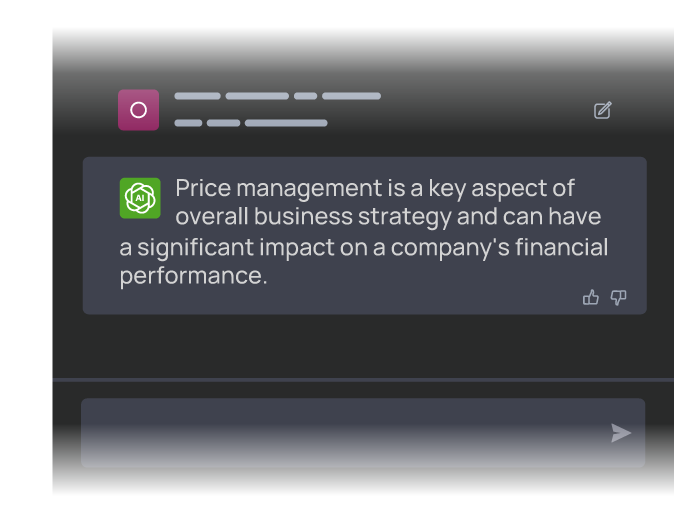Learn what price management is, how it works, a step-by-step process, and the benefits of a strong price management strategy from Vendavo Business Consultant, Chris Kennedy-Sloane.
Originally Published: June 24, 2021
Updated: February 22, 2023
What is Price Management?
It’s an interesting question. There will be many competing definitions of price management across the business and commercial world, with a variety of expectations and interactions set accordingly. Out of curiosity, we asked ChatGPT to define ‘Price Management’, and here’s the output:

“Price management refers to the process of setting and adjusting the prices of goods and services in order to meet the goals and objectives of a business. This can include determining the optimal price point to maximize profitability, as well as implementing strategies to respond to changes in the market and competition. Price management is a key aspect of overall business strategy and can have a significant impact on a company’s financial performance.”
This is a fairly vague definition, which reinforces the view that generally the understanding of Price Management varies, and so consequently a discrete and specific answer can’t be rooted out by the AI’s algorithms. Everyone talks about pricing management, but nobody really knows exactly what it is, they only know what it means to them and their business.
Even those who manage prices for their business often struggle to relate what they are doing to the business’ improved performance and enhanced capabilities. What I’ll try to do today is to formalize how you can do that better, and consequently enhance the value of price management and the pricing department in general in the eyes of the c-suite.
Let me re-draw one piece of information that ChatGPT felt was key enough to highlight in its definition:
Price management is a key aspect of overall business strategy and can have a significant impact on a company’s financial performance.”
-partial ChatGPT response to prompt about price management
This is a very important message, and one we’ll come back to again later in this article.
Why Do You Need to Manage Prices?
Even the most simplistic of businesses require the ability to manage prices. Technically, you could call any of these methods of managing pricing a ‘Price Management System’, but in practice we know that something described as a system can be simplistic and almost dangerous. I imagine the statement will resonate with a lot of my audience here.
We manage our prices using Excel Sheets spread across the organization.”
-Most organizations with low pricing maturity
This is often the most common scenario in businesses with relatively young pricing functions, or relatively low pricing maturity. And we know that this is the most common type of organization, so consequently this is what we see most frequently. But, it’s incredibly risky for businesses to manage pricing in this way.
The Risks of Manual Price Management
Of course, the standard risks apply here. The risk of human input errors causing the proliferation of incorrect pricing. The risk of jungle knowledge, with complex and labyrinthine excel spreadsheets requiring training and maintenance. The risk of the mutability of the spreadsheets and the lack of real user access control allow unscrupulous actors to change prices to their advantage.
But these are mundane risks, with limited potential damage to an organization from a capability and financial perspective. The real risks of an underdeveloped price management system are more insidious, and less overtly visible. Let us consider an example scenario.
Imagine a road, late at night – There are two petrol stations, one on either side of the road, both owned by the same organization. One was recently built, and the other is now a little tired having been built some time ago. They have just heard that petrol prices are to rise, significantly, due to economic conditions.
The newly built petrol station merely has to key in the new price, and this appears automatically on the digital sign and on the petrol pumps. However, the older station requires manually changing the letters on the signage, and updating the pumps one by one. In order to do this, the petrol station must be closed briefly while the sole employee makes the changes.
Consequently, all transactions undertaken at the lower price before the price can be updated are at a reduced price, and a reduced margin. The opportunity cost of the lack of pricing agility is high, but not necessarily easy to understand. In this simple scenario it is easy, you can merely calculate how much petrol was sold at the old versus new price. But in more complicated businesses, this can very much be a ‘known unknown’ where this cost is known to exist, but sizing it accurately is difficult.
This difficulty can lead to businesses ignoring or minimizing this opportunity cost, and unless the real value that pricing agility provides is made clear this is easy enough to do. After all, we never had that revenue, so it’s not ‘lost’, is it? As pricing professionals, we know of course this isn’t true.
The Benefits of a Strong Price Management Process are Legion
Businesses rarely set out to create a Frankenstein’s monster of a price management system. They inevitably do so over time. Let’s take a look at the absolute basic components of the most basic price management system, driven by excel:

We have our SKU, name, cost, margin and then of course a price. This is the most basic execution of cost-based pricing, and probably it is where the vast majority of businesses have started out. We know there are hundreds of other price management strategies: value based, attribute based, volume based. I won’t opine on which is most appropriate here, but rest assured any of these would begin to add more complexity to this oh-so-simple spreadsheet.
Inevitably as the business demands more complexity from its pricing management system, the manual workload proliferates. Manual workload begets human error, and slowness of response, and errors create caution.
We should be careful not to rush things. Imagine what would happen if we sent out the wrong prices!”
-stagnant pricing teams
Have you heard this refrain? This is where the true benefits of price management systems begin to bear fruit. Manual management of prices in the long term is unsustainable, and it will reach a point of critical mass. Because you have many independent actors (aka people managing price) that are working on it with their own viewpoints and way of doing things, you end up with prices that are not managed well for profitability, and you also create inefficiencies in processes.
Pricing teams become administrators, not strategic change agents, managing and synthesizing data to load into a system. They are not adding value and creating innovations that can improve revenue and margin within their business, they are simply managing against the risks of a poorly controlled manual price management system.

All of this can be resolved simply through the use of price management software. This frees the pricing team from these constraints by building trust in the pricing management system, creating a single source of truth of data for pricing and allowing automatic cleaning and management of inputs and outputs.
A price management system supported by appropriately configured price management software enables agility, allowing pricing strategies that may not have been possible previously to become available. Changing price frequency can combat competitor pricing movements better, increasing the share of market and margin.
Manual work is reduced or eliminated. ERP and CPQ can be integrated directly to the system, by virtue of the price management software’s data connectors. No more time spent doctoring and prepping sheets to load from a central pricing team, and with a single source of truth for pricing data many errors are eliminated alongside this.
Finally, a true pricing management system embeds the ability to analyze and understand the latent insights available within your data. Comparative metrics can be embedded, with net price compliance, normal distribution tracking and exception tracking allowing your new-found agility to be employed to react swiftly to reduce margin erosion, or capitalize on potentially lucrative market trends.
The Price Management Process – Step by Step
So, let us be practical. What do we need to do in order to create a pricing management system that works successfully?

- We must first define the data critical to our pricing. What are we using to drive our pricing, and what is imperative? Discard that which is not key, allowing that simplicity creates both the ability to understand from those even outside the pricing organization, but also that it supports the agility of price movement that has already been shown to be key.
- We then segment our products and marketplaces into the dimensions which are most critical to the validity and applicability of prices. This segmentation increases price realization while reducing lost business, and it allows pricing finesse to be increased gradually as the understanding of the pricing team about the complexities of the smaller segments grows.
- At this point, a mature organization may then simulate and analyze, forecasting the potential impact of their proposed changes on the volume, revenue, margin and any other KPIs that they see as important to their business. With confidence in their proposed solution, they can move forwards.
- Pricing must be communicated. This can take many forms, but most commonly and simply as a suggested pricing to our sales colleagues, through ERP or CPQ software. Supporting measures, like target, stretch and floor pricing can come alongside this, but pricing guidance must always be easy to ingest and use.
- At the end, we measure. Were our simulations and analyses correct, do we need to adjust these in the future, is action required to resolve issues or correct mis-steps?
- Finally, we accept that the market has changed, and we begin again from step 1, adjusting our Pricing arrangement to suit the new environment.
This of course is the key element of a price management system, that it becomes cyclical. The more frequent that cycle – Enabled to grow faster and faster through price management software – The greater the potential revenue gain. This is a basic summary, more complexity could exist or be added, but these are the fundamentals.
A Good Pricing System is the Foundation of a Profitable Business
Cast your mind back to the definition created by ChatGPT for us, and that final sentence.
Price management is a key aspect of overall business strategy and can have a significant impact on a company’s financial performance.”
-ChatGpt response to prompt
At Vendavo, we think this is perhaps underselling the importance of price management. Very few measures of success within a business are not touched directly or indirectly by the prices of that businesses’ products, and no lever of sales and profitability has such an outsize impact as setting the correct price at the correct time.
So many businesses are still feeding their Frankenstein’s monster of a price management system, unsure how to get away from a damaging and codependent relationship. Vendavo can help, and if you’re looking to execute straightforward, scalable price management across your organization? Vendavo Pricepoint is your answer.
